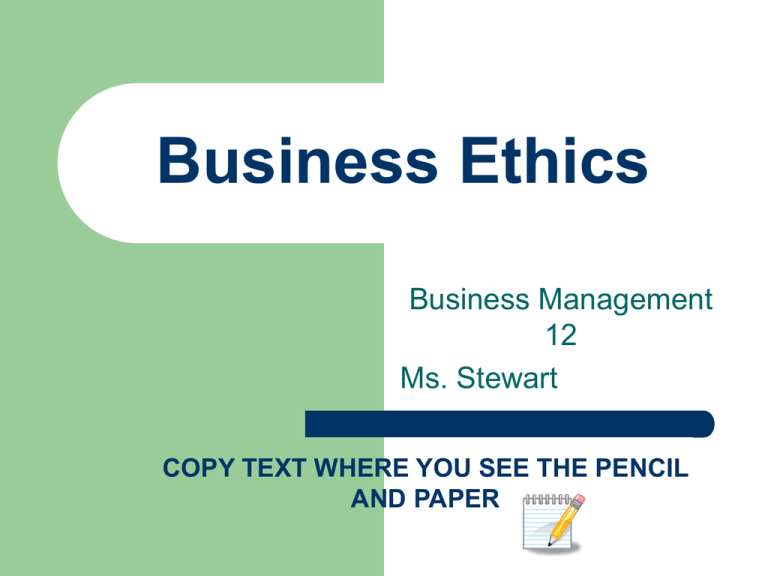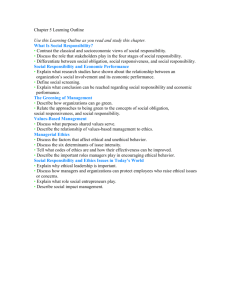Ethics PPT
advertisement

Business Ethics Business Management 12 Ms. Stewart COPY TEXT WHERE YOU SEE THE PENCIL AND PAPER What is business ethics? Ethics – study of what is good and evil, right and wrong, and just and unjust Business ethics - a code of professional standards, containing aspects of fairness and duty to the profession and the general public Discussions of business ethics frequently emphasize unclear situations However, applying clear guidelines resolves the majority of them Ethics and Managers Managers act in different ways according to their own moral standards, values, personal experiences and the culture of the organization. Surveys International Survey of more than 300 companies worldwide – top ethical issues: – Employee conflict of interest 91%, – Inappropriate gifts 91%, – Sexual Harassment 91%, – Unauthorized Payments 85% Surveys - Incidence of unethical behaviors in areas (from a Wall Street Journal survey): – Government: 66% – Sales 51% – Law 40% – Media 38% – Finance 33% – Medicine 21% – Banking 18% – Manufacturing 14% Common Examples Individual values and the company: – Receiving or offering kickbacks – Stealing from the company – Padding expense accounts to obtain reimbursements for questionable business expenses – Divulging confidential information or trade secrets – Using company property and materials for personal use – Conflict of interest Language of Ethical Lapse Everybody else does it – Not a valid choice – specially if law is being broken If we don’t do it, someone else will That’s the way it has always been done We’ll wait until the lawyers tell us it’s wrong – What’s legal may not be ethical It doesn’t really hurt anyone The system is unfair Individual Determinants Religion Moral Philosophy Cultural Differences Ethical Philosophies CODE OF ETHICS A formal document that states an organization’s primary values and the ethical rules it expects managers and employees (operatives) to follow. What is the managers responsibility? TO MAXIMIZE PROFITS? TO PROTECT AND IMPROVE THE WELFARE OF SOCIETY? Social Responsibility An organization’s obligation, to pursue long term goals that are good for society Social Obligation The obligation of an organization to meet its economic and legal responsibility and no more Social Obstruction Organizations do as little as possible to solve social or environmental problems. Example: Pollution (the law is broken or a practice becomes unethical – often the problem is covered up or hidden) “Erin Brockovich” Social Response An organization meets its basic legal and ethical obligations and also goes beyond social and obligation in selected cases Example: IBM will match employee contributions but have to be solicited first – not voluntary Social Contribution An organization views itself as a citizen in a society and proactively seeks opportunities to contribute to that society. Example: Ronald McDonald House program run by McDonald’s Corp.





